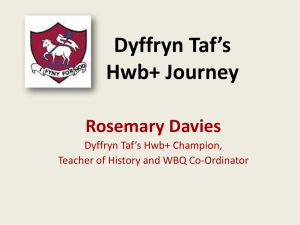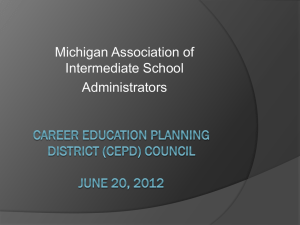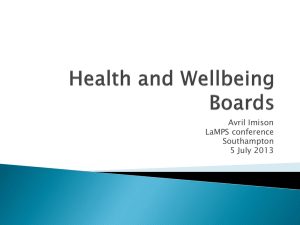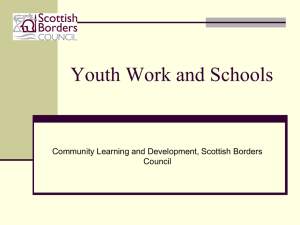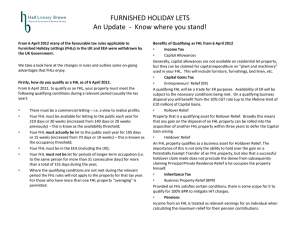第二章航協電子貨運前瞻 - 台北市航空貨運承攬商業同業公會
advertisement
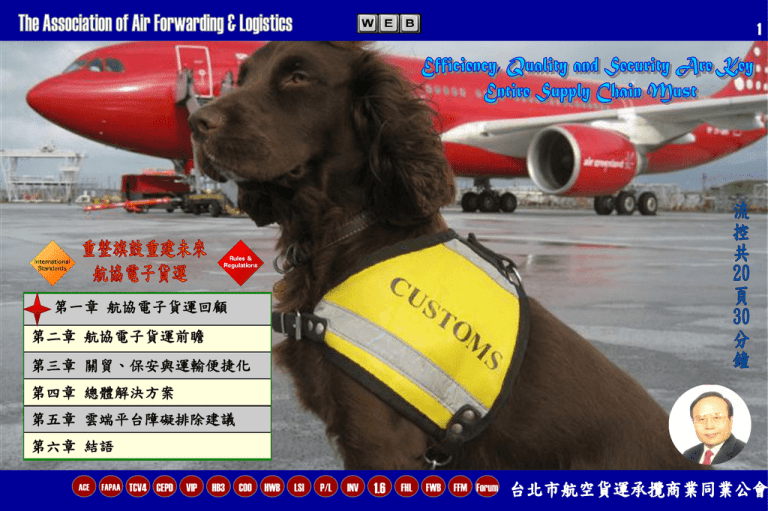
1 第一章 航協電子貨運回顧 第二章 航協電子貨運前瞻 第三章 關貿、保安與運輸便捷化 第四章 總體解決方案 第五章 雲端平台障礙排除建議 第六章 結語 ACE FAPAA TCV4 CEPD VIP HB3 COO HWB LSI P/L INV 1.6 FHL FWB FFM Forum 第一章 航協電子貨運回顧 一. 加值網路與作業系統服務提供者寡佔, 政府主導市場;系統無法與國際標準接 軌,不論訊息、文件範圍、內容或認知, 亦無法與國際標準接軌,不論產、官或 學重複輸入嚴重。資訊費率支付無標準, 導致業界作業成本高漲。 二. 商業族群無法依賴資訊服務提供者,習 慣等待政府計畫輔導,績效不彰降低台 灣競爭力。 三. 製造業出走,電子航貨配合貿易需求, 資訊呈現出結構性改變,政府主管官署, 空運運籌服務業必須擁有國際接軌能力, 否則必然自核心市場出局。 四. 長期投資政策搖擺,期望政府及時提供 公共平台環境,以便業界永續經營。 法律 工作組 群 商業 工作組群 法律 工作組群 技術 工作組群 VAN 技術 工作組 群 商業 工作組 群 台灣由付費受害者自力救濟 資訊來源:UN CEFACT / TB G2 ACE FAPAA TCV4 CEPD 國際由政府與資訊服務提供者主導電子航貨發展、宣導與推廣。 VIP HB3 COO HWB LSI P/L INV 1.6 FHL FWB FFM Forum 2 第一章 航協電子貨運回顧 關務部份必須注意訊息標準 與電子文件內容請參考 附件三 資訊來源:WCO 2009 N60 資訊來源:WCO 2009 N60 + IATA V In Pack 1.0 ACE FAPAA TCV4 CEPD VIP HB3 COO HWB LSI P/L INV 1.6 FHL FWB FFM Forum 3 4 1. Integrated S C Management 2. Cargo Inspection Authority 3. Modern Technology Equipment 4. Risk-Management Systems 5. High-risk Cargo or Container 6. Advance Electronic Information ACE FAPAA TCV4 CEPD VIP HB3 COO HWB LSI P/L 7. Targeting and Communication 8. Performance Measures 9. Security Assessments 10. Employee Integrity 11. Outbound Security Inspections INV 1.6 FHL FWB FFM Forum 1. Partnership 2. Security 3. Benefits 4. Technology 5. Communication 6. Facilitation 第二章 航協電子貨運前瞻 5 商 業 端 貿易 關務 運輸 貿 易 、 運 輸 暨 關 務 訊 息 暨 電 子 文 件 The industry bodies (CC, CSC, CBPP, CPCMG…) endorsed the move toward XML and agreed that: 1.Where no standards existed the Cargo XML Task Force shall develop XML standards (e.g. Invoice) 2.For core CIMP messages that should have an XML equivalent the Cargo XML Task Force shall develop shall develop XML standards 3.In 2009 5 messages would be developed in XML: House Waybill, AirWaybill, Letter of Instruction, Declaration for Dangerous Goods, House Manifest 4.In 2010 6 messages would be developed in XML: CITES, Flight Manifest, Freight Booked List, Transit Dec., Security Declaration, Status Message 5.IATA will stop maintaining CIMP after 2014 but parties can still exchange CIMP messages beyond 2014 (the option will be reviewed) ACE FAPAA TCV4 CEPD VIP 資訊來源:IATA CAG YVR 2010 03 08 HB3 COO HWB LSI P/L INV 1.6 FHL FWB FFM Forum 第二章 航協電子貨運前瞻 6 100% 90% Root Cause Analysis & Message Import Program 100% 87.6% 87.6% 1. 87.6% 74% 80% 74.4% 70% 2. 60% 48% 50% 48.3% 3. 4. 40% 29% 30% 20% Expansion of product (scope of shipments covered by the EF standards and processes, and scope of electronic documents) to continue to increase its attractiveness Increase in geographical capability (locations and airports where EF is implemented) Growth of stakeholder adoption (airlines, forwarders, shippers live on EF) Growth in penetration of EF shipments (EF volumes) on live trade lanes between live stakeholders 10.90% 10.9% 09.10% 9.1% 11% 10% 9.1% 9.90% 2.00% 2.0% 2.00% 2.0% 0.17% 0.17% 0.07% 0.04% 0.17% 0.04% 0% 1 Locations 2 Liv e 3 Targeted 4 Targeted 5 Airports 6 Airlines 7 Forw arders 8 Tradelanes 9 EF Scope Locations Tradelanes Airports Capability Adoption Adoption Penetration Penetration EF - Four dimensions for EF growth ACE report FAPAA 2010.03.08 TCV4 CEPD VIP HB3 COO HWB 資訊來源:CAG IATA Cargo 10 © International Air Transport Association 2010 LSI P/L INV 1.6 FHL FWB FFM Forum 第二章 航協電子貨運前瞻 documents in scope are: 1. Invoice 2. Packing List 3. Certificate of Origin 4. Shipper’s Letter of Instruction 5. Dangerous Good Declaration 6. Export Goods Declaration 7. Customs Release Export 8. House Manifest 9. Master Air Waybill 10. House Waybill 11. Export Cargo Declaration 12. Flight Manifest 13. Transfer Manifest 14. Import Cargo Declaration 15. Import Goods Declaration 16. Customs Release Import 17. Security Declaration (electronic messaging standard to be defined in 2010) 18. Convention on International Trade in Endangered Species (CITES) Certificate (electronic messaging standard to be defined in 2010) 19. Transit Declaration (electronic messaging standard to be defined in 2010) 20. Freight Booked List (FBL) (electronic messaging standard to be defined in 2010) ACE Source: IATA CAG Mar2010 FAPAA Advance security assessment information response Conveyance report TCV4 CEPD VIP HB3 COO HWB LSI P/L INV 1.6 FHL FWB FFM Forum 實 質 支 政援 府貿 端易 便 請捷 配化 合、 法航 規空 層保 面安 支暨 援節 能 減 碳 7 第三章 關貿、保安與運輸便捷化 8 Security/Storage CIQ / Air Police/Port authority Interface 政府端 接軌平台 公雲 Airlines, Forwarder/ Customs Broker/Shipper SaaS Interface PaaS 商業端 接軌平台 私雲 Common Database 通用 資料庫 純雲 IaaS Comprehensive, Transparency, Flexibilities, Cooperative 商業端 依據受惠者 付費基本精神 We Say Yes World Trade Organization World Trade Harmonization DOHA UNECE UNECETF EFIFACT Recommendations UNXML Including single window SP & DATA Models ISO 法規端 創制或修正合乎公法 國際公約之規範 ISO15400 ISO T372 ebxml YMM&CCTS Methodologies United World Customs Framework of Data modelv2 EC Customs TAXUD e customs 2007 MC99, MP4 技術端 Stakeholder 1.訊息與電子文件內容轉譯、邏輯檢查 Local e FOP 2.路由介接與平台基礎功能〈IATA Vendor Information Pack 1.0〉 3.作業系統雲端運算、儲存與績效分享。 Comprehensive, Transparency, Flexibilities, Cooperative 政府端貿易、關務、運輸與保安整合 貿易便捷化 Trade Facilitation 航空保安 Air Security TCV4 CEPD VIP HB3 Source: IATA e freight/www.tafa-r.org.tw/IATA e Freight ACE FAPAA COO HWB LSI P/L INV 1.6 FHL FWB FFM Forum WTO UN/ECFACT ISO TC154 WCO 第三章 關貿、保安與運輸便捷化 CCS/Internet 工具 Cooperative 創意 Common Data Base 原產地“純雲、私雲、公雲” 證明 “覆雲”範圍 商業 發票 Comprehensive 裝箱 單 原產地 證明 主艙 單 “公雲” Transparency 商業 發票 裝箱 單 原產地 證明 FAPAA 關 務 分提 單 保 安 “私雲” Cooperative 檢 疫 檢 驗 商業 發票 Flexibilities “覆雲” 產 證 裝箱 單 原產地 證明 關務文件 CIQ Open 貿易文件 Trade 系統 Flexibilities Single Window 運輸文件 Transport Co-share 邏輯 Security ACE 分艙 單 裝箱 單 危險品 申報 裝箱 單 商業 發票 主提 單 商業 發票 原產地 證明 TCV4 CEPD VIP HB3 COO HWB LSI P/L INV 1.6 FHL FWB FFM Forum 9 第四章 總體解決方案 SaaS Evaluation Element 系統分析文件 1) System Applicability 系統目的:支援雲端運算作業 • 系統功能 :主系統與各個子系統功能說明 基本資料: 2) System limitation 資料作業維護:資料日報表 資料作業: 4) Scope of System Service 資訊安全 二. 系統特色: 可處理多筆資料同時輸入,系統連線自動產生各類表單 三. 限制條件 5) System Classification 四. 作業流程:現況說明,以IDEF或是DFD分析 五. 系統說明文件 八. 檔案結構 (資料字典) 6) Structure of System Database 國際條碼 本欄位長度最少 位 商品貨號 本欄位長度 位為原則 商代號與廠商貨號 本欄位長度最少為 位 九. 輸入方法 7) Glossary &Identification 十. 輸出格式 (表單、螢幕、印表機) 十一. 各項報表、統計表 十二. 檔案系統架構:系統關聯圖 8. Output abilities 十三. 使用者權限說明:新增、查詢、列印、修改 十四. 程式說明文件 9. Mapping & Standard compliance 十五. 程式設計方法 十六. 作業流程處理邏輯 操作說明文件 10. e Freight Utilities support 系統啟動 系統操作 系統關機 系統備份 障礙排除 使用者說明文件 系統的功能 運作程序 十七. 表單輸入 填寫方法 1. Covert Channels)ISO/IEC 2382-8; Steganography 十八. 輸出資訊使用方法 2. 信號雜訊比(Peak Signal to Noise Ratio ,PSNR)大於或等於30dB 十九. 國際標準介接 二○. 路由與資訊導入能力 ACE FAPAA TCV4 CEPD VIP HB3 COO HWB LSI P/L INV 1.6 FHL FWB FFM Forum 11 第五章 雲端平台障礙排除建議 PaaS Forwarding/ Customs Brokerage Interface 航承暨報關 作業/接軌平 SaaS 台 VIP HB3 COO HWB LSI P/L INV 1.6 FHL FWB 私雲的目的有二 一者是整合LSP內 部資源;一者則 Forwarding/ CIQ 是進行 Brokerage Data base 商業端 IaaS Chain Supply/Demand 資訊儲存平 結合,空運供應 台 商共用一個平台, 提昇效率。 Private Cloud TCV4 CEPD Public Cloud FAPAA IATA e Freight BWG 遴選出三到五個雲端 應用系統提供者 結合全球的資源,提供 SaaS虛擬單一窗 業者行銷、營運管理和 口 底層的硬體架構支援, 航空貨運作業平 最後協助業者將服務放 臺 在雲端資料中心,正式 Information Barebones System 商業化。 Public Cloud- MTA Business Layer Forwarding/ Customs Brokerage Interface 航承暨報關 作業/接軌平 台 Private Cloud ACE Public Cloud Governance Risky Compliance Logic & Risky Activities Management Logic邏輯與風險 Check In-Out管理平台 & Transit Security 7. Credit reference 8. Other function related to security Technology IaaS Objective Business Layer 政府端 接軌平台 保安與訊息 轉譯接軌平 台 Presentation Layer Private Cloud Forwarding/ Customs Brokerage Interface 1. 2. 3. 4. 5. 6. Message Mapping Interface FFM Forum 12 第四章 總體解決方案 13 航空公司接收主提單訊息(僅包含 貨主與收貨者的細部資料),且每 個訊息僅夾帶一張分提單 貨物進倉(倉棧或航空公司)確認 目的地機場接收貨 物訊息 Forwarder Statuses: •PUP: Proof of Pick up •REW: Received warehouse •DOC: Documents cleared •RIH: Received inbound house •OFD: Offloaded •POD: Proof of pick up export AIR WAYBILL DATA (FWB) MESSAGE 貨物出口裝機與起飛確認 承攬業接收貨物 import ACE FAPAA TCV4 CEPD VIP HB3 DSG-Tradevision - a part of Descartes Systems Group Inc COO HWB LSI P/L INV 1.6 FHL FWB FFM Forum 第五章 雲端平台障礙排除建議 14 1 2 2 1 IATA e Freight BWG Cloud Computing SaaS PaaS IaaS Core Cloud Service 4 4 2 2 4 4 4 ACE FAPAA TCV4 CEPD VIP HB3 COO HWB LSI P/L 3 Service Provider 1. CHAMP http://www.champ.aero 2.CARGONAUT http://www.cargonaut.nl 3.GLS HGK http://www.glshk.com 4. NIIT DXB http://www.niit-tech.com 5. Mercator http://www.mercator.co 6. TravelSky httpwww.travelsky.net 7. Traxon EU http://www.traxon.com 8.UNISYS US http://www.unisys.com/transportation INV 1.6 FHL FWB FFM Forum 15 2010 Activities Progress to achieving targets and mandate: 1) Expanding the EF product scope 2) Increasing geographic capability (locations and airports) 3) Encouraging adoption by new stakeholders 4) Growing volumes (EF shipment penetration) IATA e-freight beyond 2010: targets and mandate ACE FAPAA TCV4 CEPD VIP HB3 COO HWB LSI P/L INV 1.6 FHL FWB FFM Forum 16 ACE FAPAA TCV4 CEPD VIP HB3 COO HWB LSI P/L INV 1.6 FHL FWB FFM Forum 18 ACE FAPAA TCV4 CEPD VIP HB3 COO HWB LSI P/L INV 1.6 FHL FWB FFM Forum 19 ACE FAPAA TCV4 CEPD VIP HB3 COO HWB LSI P/L INV 1.6 FHL FWB FFM Forum 20 1) IATA proposed to use the table enclosed in Annex 2 of these minutes to list the codes in the “Other Customs/Control information” description field of the XML House Manifest, which was agreed by the Members. 2) There were some concerns/confusion over how the message would be used. 3) Many carriers think they only need the FHL (details) function and think the House Manifest should include shipper, consignee and charge declarations because forwarders would not want to send their House Waybill level data with rating to the airline. 4) It was re-confirmed that the agreed approach was to have the House Waybill take care of that level and if an airline had to report HWB details then they would need House Waybill messages from the forwarder. However, the House Waybill message is flexibly designed so the forwarder could only send the airline the bare minimum required for Customs purposes – not rating level. 5) IATA explained that this would not be so different from today (example flows are shown in Annex 3). 6) There was some speculation that perhaps the house manifest (check list) would no longer serve a purpose. It was noted that perhaps down the road the checklist with authorization numbers, e.g. MRN in the EU, might be all that is needed. It was considered too soon to make such a determination and it was agreed that the XML version should still be made available. 7) IATA reminded the Members that the XML House Manifest served the purpose of a Check list and would thereof only be equivalent with the CIMP FHL Check List (function 1). Members questioned the need of the electronic XML House Manifest message and proposed to proposed to verify in their systems if current FHL Check List (function 1) were used or not. 8) Task Force Members are asked to verify in their respective systems if current FHL Check List (function 1) were used or not and to come back to the group ACE FAPAA TCV4 CEPD VIP HB3 COO HWB LSI P/L INV 1.6 FHL FWB FFM Forum 21 -IATA asked the members to consider participating in a Proof of Concept exercise for the use of the new XML messages. -- Members expressed their interest to take part of a Proof of concept, such as INDITEX, CATHAY PACIFIC, UNISYS, TRAXON and DESCARTES. -- Members mentioned that the proof of concept should be agreed upon between partners and perceived benefits should be expressed, e.g. the capability of exchanging XML messages over the Internet. -- In addition, members proposed to have a technical recommendation for the business needs, e.g. -preferred protocols to transfer messages, tag names requirements (Upper/Lower Case), character set (UTF8), security in data transfer, etc. -- Some members raised the concern regarding the reporting of errors and the availability of response messages in the proof of concept and agree that these issues will have to be addressed further and that ideally error handling needs to be in place. ACE FAPAA TCV4 CEPD VIP HB3 COO HWB LSI P/L INV 1.6 FHL FWB FFM Forum

